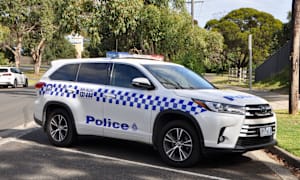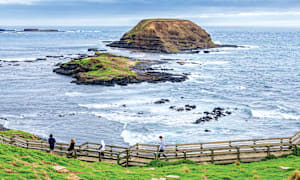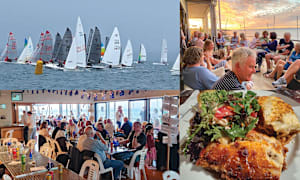
The first island bridge opened in 1940.

The first bridge was built west of the San Remo jetty

Many people on Phillip Island in the 1930's gave a tremendous amount of time and effort to persuade the government of the day to build a bridge linking Phillip Island with the mainland.
It was a long and difficult struggle, but in spite of difficulties and disappointments, those concerned did not at any time lose faith, that a bridge would ultimately be built.
Support for a bridge was not unanimous, however.
The company that controlled the only means of transport on and off the island, operating both the ferry from Cowes to Stony Point and the Punt from Newhaven to San Remo, did not see the necessity for a bridge; and tried to persuade the people of Phillip Island not to support the idea.
The council of the day opposed it.
Letters to the Powlett Exprss showed it was one of the most divisive issues of that era.
Those against argued that day trippers would start coming to Phillip Island; that they would not spend the money that longer staying visitors would; and that the island would get “riff raff” coming.
History records that Richard Grayden, and Mr Rupe Harris, a Phillip Island councillor for 20 years, did and gave much to ensure that eventually, a bridge from San Remo to Newhaven would be built.
A tribute by island historian Josua Gliddon on the death of Mr Harris in 1971, rcords that: “In association with the late Dick Grayden and John Edhouse, Mr Harris’ ability to organise and direct, plus his tenacity and purpose, resulted in the construction of the first Phillip Island bridge.”
Life before a bridge was built to Phillip Island
Phillip Island’s pioneers and early settlers brought stock and supplies from, and transported their crops to Melbourne, in the years following settlement, by sailing ship.
There was no other option available to them.
The journey from Western Port to Port Phillip Bay and back was often a hazardous one. Passengers could sail or row to the Mornington Peninsula and then be carried by coach to Melbourne.
A punt was used on Western Port and used for carrying livestock around the bay from 1878.
It’s loading facility at Cowes was known as the Tide Gauge, a ramp at Erewhon Point.
It was towed by the ferry. By 1928, it was rotting in the sand at San Remo according to the Argus newspaper.
After the Koo Wee Rup swamp was drained in the early 1900’s, coaches and later motor vehicles were able to reach Griffith's Point (now San Remo) by road.
From San Remo, people were rowed across the narrows to Newhaven by Richard Grayden.
Stock were not so lucky. They had to swim between San Remo and Newhaven from 1908 until the 1920's.
A two car punt in operation
In 1929, Phillip Island was able to be reached by a two car punt, plying between San Remo and Newhaven.
By 1938 this had been replaced by a six car punt.
Large vehicle ferries taking 36 cars and 400 passengers also ran between Cowes and Stony Point.
The Cowes ferry made one trip per day, except at peak holiday time, when it ran frequently.
The punt ran as required during daylight hours.
It cost travellers 10 shillings per car and 2 shillings 6 pence per person, to use it.
The approaches to the punt were so bad that vehicles had to be driven at times through fast flowing salt water.
The economic justification for a bridge was obvious to Phillip Islanders.
As Josua Gliddon in his book “Phillip Island in Picture and Story” remarked, everything worth having has to be fought for, and this was certainly true about the first bridge.
The ferries and the launch towed punts, although giving good service, were beginning to fall short of the needs of modern transport.
The push for a bridge was headed by one of Phillip Island’s pioneers Richard Grayden, who had talked constantly of it since the early 1920's.
Having been a boatman at Newhaven for many years, he knew the Passage well, he believed the idea was sound, and he never lost faith in it.
Pressure from locals was brought to bear through the formation of "The Bridge League in the late 1930’s.
In 1936 a branch of the Victorian Country Party was also formed on Phillip Island, for the express purpose of garnering government support for a bridge.
Richard Grayden was president, and Mr Rupert Harris secretary.
At the first meeting Mr Harris, who subsequently gave unstintingly of his time and money and travelled many times to Melbourne, moved that all in the Party's power be done to persuade the Government to build a bridge.
He took many trips to Melbourne as Chairman of the Chicory Marketing Board, and took the opportunity to haunt the corridors of power in Parliament House, lobbying for a Phillip Island Bridge.
The issue was a divisive on at the time with the council and many individuals opposing it.
However, an overwhelming “yes” vote of locals at a meeting held in 1938 in Cowes, attended by the Victorian Premier Mr Albert Dunstan, finally decided the matter.
In April 1939 the first pile was driven.
Twenty months later, on Friday, November 29, 1940, te great day came. The bridge was opened by Victorian Premier Albert Dunstan; his wife cut the ribbon, and leading the celebration march across were the children from Ventnor Primary School.
Una Lyons (nee Coels) who celebrated her ninetieth birthday recently, remembers the day well.
She was in the first row of school children to march across when the ribbon was cut.
She recalls that 1940 and te opening of the suspension bridge brought about a change that was to heavily impact the lives of everyone on Phillip Island.
To celebrate the occasion, a ball was held that evening in the Cowes Shire hall.
The suspension bridge
Building the first bridge was no easy feat.
Funds were limited and the engineering problems of bridging the channel between Phillip Island and the mainland were tremendous due to the depth of water, strong tidal conditions and need for a clearance for fishing vessels to pass under.
It was therefore decided to construct a suspension bridge, to cater for loads up to six tons, which could be built for an outlay of about 50,000 pounds ($100,000).
Work started on a bridge 1,765 feet long and 18 feet wide between kerbs with no footway, but with six pedestrian refuges along its length.
The 550 feet long suspension span crossed the section of deep and fast tidal water which would otherwise have entailed costly foundations.
The main cables used were second-hand, and came from the North Shore bridge, Sydney; and second—hand cable hangers from the Tramways supported the wooden decking.
By June 30, 1940, anchors and temporary trestles for construction purposes on the Newhaven approach, piers, suspension span towers and most of the decking on approach spans to Newhaven, plus 75 sheets of plans were completed, for 32,683 pounds.
When erecting the steel towers for the suspension cables, they had to be guyed with cables across the main span and back due to movement of up to two feet at the top, until the main cables were finally loaded with the dead weight of the suspension span.
It was not the general rule but some piles with tapering sides penetrated less than those with parallel sides.
The length of the suspension bridge was 1765 feet, and the width of te roadway between kerbs was 18 feet.
Cost of construction was 62,000 pounds, and the upkeep 50 pounds per week.
When built, it was the longest single span of any construction in Victoria, and a most picturesque scenic attraction for San Remo and Phillip Island.
Load limit a problem
While the suspension bridge gave good service over a 30 year period, its load limit caused some difficulty.
Passenger buses had to off—load their passengers, who had to walk the 588 yards across, and then re board on the other side.
Stock and goods too, could only be taken across in limited loads, though evidence showed this was not always observed.
Ted Jeffery, who ran a transport business at Newhaven, recalls the load limits well.
Tray trucks were needed as the bridge had a 5 ton load capacity.
This limitation meant that heavier loads had to be broken up and driven across in lots.
“It was hard work and time consuming because we’d have to go over and back across the bridge from Newhaven to San Remo, and then reload and go on to places like Newmarket or wherever,” said Ted, back in 2014 in an interview with the Advertiser.
“But for many of us locals, we’d chance it when we thought that the CRB (Country Roads Board) inspectors weren’t around to check on us.”
One night such exploits backfired, however.
“It was one summer evening and I thought I’d give it a go. I had a load of fat lambs on board and decided to go across in one hit. As I got closer to the middle, to the top of the arch, I heard an almighty bang. One of the cables snapped and the arch of the bridge dropped down by about a foot – but it felt like a lot more!
“At that time the CRB personnel were painting the structure and having their tea break in the shed in the work yard.
“When they heard the noise they came running out like rabbits out of the burrow!
“The next day the CRB arrived with a set of portable scales and checked every load that went over the bridge.
“It got to the stage when passengers on the buses coming down to see the penguins had to alight at San Remo and walk across the bridge and be picked up at Newhaven.
“Needless to say this didn’t happen on the return trip to Melbourne, after dark, and when the inspectors had gone.”
Statistics
The bridge was designed by Country Roads Board staff under M G Dempster, MCE, Bridge Engineer CRB of Victoria.
Mr C A Masterton, MCEA, MIE, Australia, was responsible for working out detailed design - 75 sheets.
Austral O’tis Engineering Company Limited was the contractor with Mr I J O'Donne11, BCEA, MIE, Australia, in charge of field construction until called up for active service in World War 11, in 1939.
Mr O’Donnell later became Chairman of Victorian CRB from 1963-1971. (Country Roads' Board — now VicRoads).





